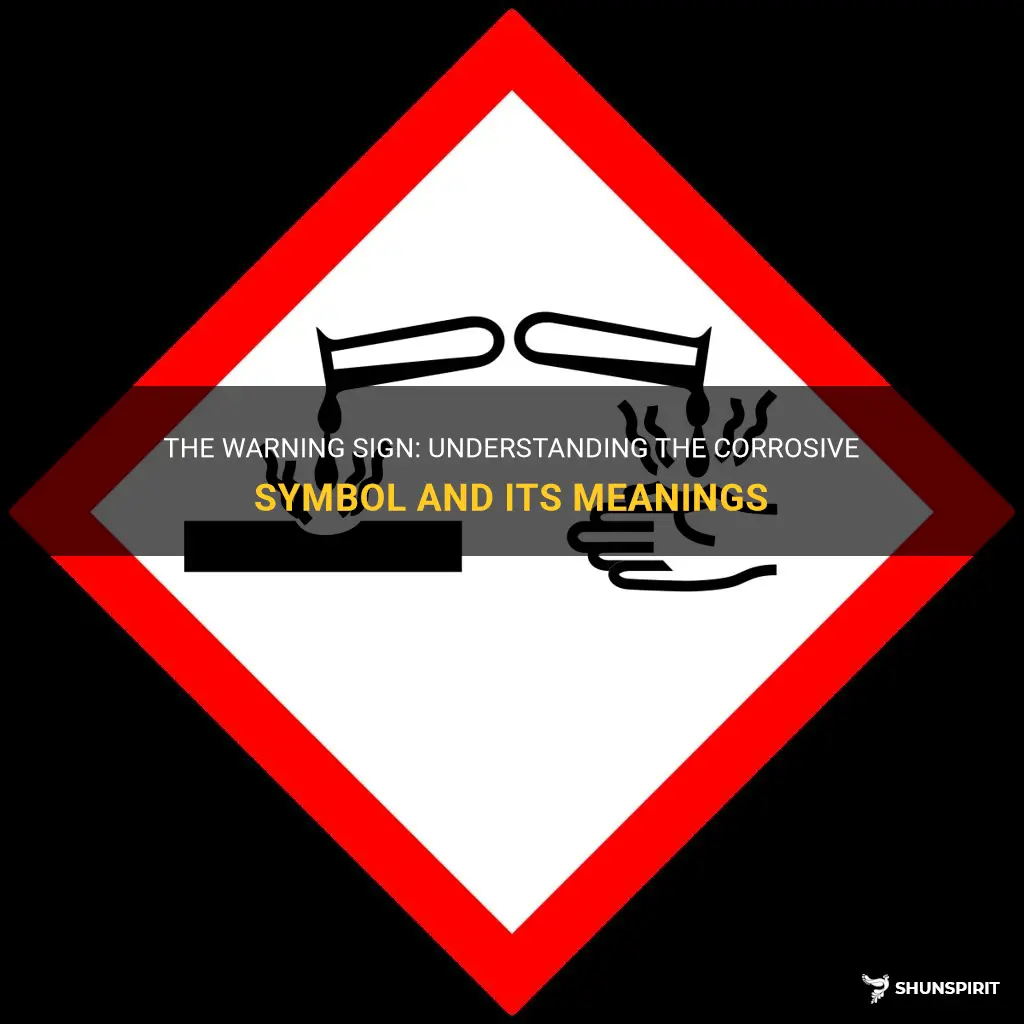
Symbols are one of the ways in which humans communicate complex ideas or concepts in a concise and visual manner. They have been used throughout history to convey various meanings and can often be found in fields such as mathematics, science, and even chemistry. One such symbol that holds significant importance in the world of chemistry is the symbol for corrosive substances. These substances, often harmful and potentially dangerous, can cause severe damage or destruction to materials they come in contact with. The symbol for corrosive serves as a warning to individuals, reminding them of the potential dangers and emphasizing the importance of handling these substances with care and caution.
What You'll Learn
- What symbol is used to represent a corrosive substance on a chemical label?
- How can you easily identify a corrosive substance by its symbol?
- Are there specific color codes associated with the corrosive symbol?
- What precautions should be taken when handling a substance with the corrosive symbol?
- Are there any specific storage requirements for substances with the corrosive symbol?

What symbol is used to represent a corrosive substance on a chemical label?
Corrosive substances can pose significant risks to human health and safety if not handled properly. To ensure the safe handling and storage of these chemicals, it is essential to use proper labeling and signage. Chemical labels use various symbols and pictograms to convey important information about the hazards associated with a specific substance. One such symbol used to represent a corrosive substance is the corrosive symbol.
The corrosive symbol is a distinctive pictogram that consists of a test tube or a beaker with a liquid spilling out and eating away at a surface. This symbol indicates that the substance it is associated with has the potential to cause severe skin burns and eye damage. It is often depicted as a black icon on a white background, but the colors may vary depending on the specific regulations or standards in different countries.
The purpose of the corrosive symbol is to quickly alert individuals to the potential dangers of a substance and remind them to take appropriate precautions. When this symbol is present on a chemical label, it is a clear indication that the substance is highly acidic or alkaline and can cause severe damage upon contact with skin, eyes, or other body tissues.
Workers and individuals who come into contact with corrosive substances must take appropriate safety measures to protect themselves. This includes wearing personal protective equipment such as gloves, safety goggles or face shields, and lab coats or aprons. It is also crucial to handle these substances in well-ventilated areas to minimize the risk of inhaling hazardous fumes or vapors.
In addition to the corrosive symbol, chemical labels also contain other important information related to the substance's properties and hazards. This may include the chemical's name, its hazard class, any specific warnings or precautions, and first aid measures in case of exposure or accidents. It is critical to read and understand these labels thoroughly before handling or using any corrosive substance.
It is worth noting that different countries or regions may have slightly different labeling requirements and symbols for corrosive substances. For example, the international Globally Harmonized System (GHS) of Classification and Labelling of Chemicals provides standardized labeling elements to ensure consistency and promote global understanding. However, some countries may have additional or alternative labeling systems in place.
In conclusion, the symbol used to represent a corrosive substance on a chemical label is a pictogram depicting a test tube or beaker with a liquid spilling out and eating away at a surface. This symbol serves as a clear warning of the substance's corrosive properties and potential for causing severe skin burns and eye damage. Anyone working with or handling corrosive substances must be aware of the associated hazards and take appropriate safety precautions to prevent accidents and injuries.
Understanding Native American Animal Symbols and Meanings
You may want to see also

How can you easily identify a corrosive substance by its symbol?
Corrosive substances are known for their ability to cause damage to living tissue or other materials through a process known as corrosion. Identifying a corrosive substance by its symbol can help individuals take appropriate precautions to handle and store the substance safely.
Most corrosive substances are labeled with specific symbols according to international standards such as the Globally Harmonized System of Classification and Labelling of Chemicals (GHS). These symbols are designed to provide visual cues about the hazards associated with the substance.
One common symbol used to indicate a corrosive substance is the "Corrosion" symbol. It consists of a flask or test tube with liquid dripping from it onto a hand or a piece of metal. This symbol is typically printed in black on a white background.
In addition to the corrosion symbol, corrosive substances may also be labeled with other symbols to indicate specific hazards. For example, if a substance is also toxic or harmful, it may be labeled with the "Skull and Crossbones" symbol. If a substance emits harmful gases or vapors, it may be labeled with the "Gas Cylinder" symbol. These additional symbols can provide further information about the potential risks associated with the corrosive substance.
When identifying a corrosive substance by its symbol, it is important to remember that symbols alone may not provide enough information to accurately assess the risks. It is essential to also consult the material safety data sheet (MSDS) or other sources of information to obtain a comprehensive understanding of the substance's properties and hazards.
If you come across a substance that you suspect to be corrosive but cannot identify it by its symbol, it is crucial to exercise caution. Treat the substance as if it is corrosive and take appropriate measures to protect yourself and others. This may include wearing gloves, goggles, and a lab coat, and ensuring proper ventilation if dealing with corrosive gases.
In conclusion, identifying a corrosive substance by its symbol can provide valuable information about the potential hazards associated with the substance. The corrosion symbol is a commonly used symbol to indicate the corrosive nature of a substance, but it is important to also consider any additional symbols and consult other sources of information to fully understand the risks. By taking proper precautions and following safe handling procedures, individuals can minimize the risks associated with corrosive substances.
Understanding the Symbolic Meaning Behind Ribbons
You may want to see also

Are there specific color codes associated with the corrosive symbol?
The corrosive symbol is a widely recognized symbol that is used to indicate the presence of corrosive materials that can cause damage to metals, living tissues, and other materials. It is important to handle corrosive substances with caution to avoid accidents and injuries. In order to provide clear and consistent information, specific color codes have been associated with the corrosive symbol.
The international color codes for the corrosive symbol are black on an orange background. This color combination is used to ensure visibility and easy recognition of the symbol. The black color used for the symbol itself is meant to stand out against the orange background, making it easily noticeable. The orange background is chosen for its high visibility and ability to catch attention.
The purpose of using color coding for symbols, such as the corrosive symbol, is to provide a quick and reliable means of identifying potentially hazardous materials. The use of color codes helps to convey information even to those who may not be familiar with the specific symbols used. By using consistent color codes, it becomes easier for individuals to recognize and understand the potential hazards associated with a particular substance.
It is important for individuals to be aware of the color codes associated with the corrosive symbol so that they can take appropriate precautions when handling corrosive materials. The black on orange color combination is used universally and can be found on labels, signs, containers, and other materials that contain or indicate the presence of corrosive substances. This helps to ensure consistency and clarity across different locations and industries.
In addition to the color codes associated with the corrosive symbol, it is also important to familiarize oneself with the specific meaning of the symbol itself. The corrosive symbol typically consists of a pictogram of a beaker or test tube pouring liquid onto a hand or surface. This pictogram serves as a visual representation of the potential hazards of corrosive materials.
In conclusion, the corrosive symbol is associated with specific color codes, namely black on an orange background. This color combination is used universally to ensure visibility and easy recognition of the symbol. Understanding and recognizing these color codes is essential for individuals who handle or come into contact with corrosive substances, as it helps to convey important information about potential hazards. By adhering to color codes and taking the necessary precautions, individuals can minimize the risk of accidents and injuries associated with corrosive materials.
Decoding the Hidden Symbols on iPhone Photos: What Do They Really Mean?
You may want to see also

What precautions should be taken when handling a substance with the corrosive symbol?
When handling a substance with the corrosive symbol, it is important to take certain precautions to ensure your safety. Corrosive substances are those that can cause damage to living tissue upon contact, including the skin, eyes, and respiratory system. They can often have strong acids or bases as their main components. Here are some precautions to consider when working with corrosive substances:
- Personal Protective Equipment (PPE): Always wear appropriate protective gear, such as goggles, gloves, and lab coats or aprons. This will help protect your eyes, skin, and clothing from any potential corrosive contact.
- Ventilation: Work in a well-ventilated area, preferably with exhaust fans or fume hoods. Corrosive substances can release harmful vapors or gases, so it is essential to have proper ventilation to prevent inhalation of these fumes.
- Storage: Store corrosive substances in designated areas that are clearly labeled and away from other incompatible materials. It is important to keep these substances properly sealed in their original containers to prevent accidental spills or leaks.
- Handling: For liquids, always use appropriate containers or bottles with secure lids to prevent spillage. When pouring corrosive substances, do it slowly and carefully to avoid splashing or releasing hazardous fumes. Never use your bare hands to handle these substances; always use proper tools or equipment.
- Knowledge: Familiarize yourself with the specific properties and hazards of the corrosive substance you are working with. Read and understand the safety data sheets (SDS) provided by the manufacturer. This will provide important information on handling, storage, and emergency procedures.
- Emergency Preparedness: Have appropriate first-aid kits readily available in case of accidental contact or exposure. Ensure that eyewash stations, safety showers, and fire extinguishers are accessible and in working condition. Additionally, know the emergency procedures specific to the corrosive substance you are handling.
- Training: Receive proper training on the safe handling and use of corrosive substances. Understanding the risks involved, as well as the necessary precautions, will help minimize the chances of accidents or injuries.
- Disposal: Dispose of corrosive substances according to local regulations and guidelines. Never pour them down the sink or toilet as they can cause damage to plumbing systems and harm the environment. Many corrosive substances require proper neutralization or treatment before disposal.
Remember, prevention is always better than cure, so it is crucial to take these precautions seriously when working with corrosive substances. By following these guidelines, you can minimize the risk of accidents and protect your health and the environment.
Deciphering the Nissan Pathfinder Dashboard Symbols and Their Meanings
You may want to see also

Are there any specific storage requirements for substances with the corrosive symbol?
When it comes to storing substances with the corrosive symbol, it is essential to follow specific storage requirements to ensure the safety of both individuals and the environment. Corrosive substances have the potential to cause severe damage, including burns, skin and eye irritations, and destruction of materials. Therefore, proper storage is crucial to minimize the risk and potential hazards associated with these substances.
One of the key considerations when storing corrosive substances is to keep them in a separate designated area. This area should be well-ventilated and isolated from other incompatible substances to prevent any accidental reactions or contamination. It is also important to store corrosive substances away from heat sources or open flames, as they can cause vaporization or combustion.
Corrosive substances should be stored in suitable containers that are chemically resistant to the specific substance being stored. Common examples of appropriate containers include glass or plastic bottles, plastic drums, or metal containers coated with an appropriate protective layer. It is important to note that certain corrosive substances may require specialized containers due to their unique properties.
In addition to using appropriate containers, it is essential to label all containers clearly with the name of the substance, its hazards, and any specific handling or storage instructions. This helps to ensure that individuals working with the substances are aware of the potential risks and take necessary precautions.
When it comes to organizing the storage area, it is crucial to consider the compatibility of different corrosive substances. Some corrosive substances may react with each other or with other chemicals, leading to dangerous situations such as the release of toxic gases or even explosions. Therefore, it is important to separate incompatible substances and store them in different areas or cabinets to prevent any accidental mixing.
Furthermore, it is advisable to have appropriate spill containment measures in place in case of accidental spills or leaks. This includes having spill kits readily available and training staff on how to respond to spills effectively, minimizing the potential for further damage or injuries.
Regular inspection and maintenance of storage areas are also necessary to identify and address any potential issues promptly. This includes checking for leaks, damaged containers, or any signs of deterioration. If any issues are identified, the substances should be properly disposed of and replaced with new containers to ensure the integrity of the storage area.
Additionally, it is important to have proper Personal Protective Equipment (PPE) available and ensure that staff is trained in its usage. This includes items such as gloves, safety goggles, and appropriate clothing to protect against potential splashes or contact with corrosive substances.
In summary, storing substances with the corrosive symbol requires careful attention to ensure safety. This includes keeping them in a designated, well-ventilated area, using appropriate containers, labeling correctly, separating incompatible substances, having spill containment measures, and regular inspection and maintenance. By following these specific storage requirements, the potential risks and hazards associated with corrosive substances can be minimized, ensuring the safety of everyone involved.
Understanding the Symbolism and Meaning Behind Passover: A Deep Dive into the Ancient Traditions
You may want to see also
Frequently asked questions
The symbol for a corrosive substance is a pictogram that consists of a black outlined, white-filled triangle with a lowercase 'C' in the center. This symbol is internationally recognized and is used to warn individuals of the potential hazards associated with corrosive materials.
The symbol for corrosive indicates that the substance it is associated with has the potential to cause damage to materials it comes into contact with, including metals, skin, and eyes. Corrosive substances are often highly acidic or alkaline and can cause severe burns and destruction if not handled properly.
The corrosive symbol can be found on the packaging or labeling of any product that contains a corrosive substance, such as certain cleaning agents, batteries, or industrial chemicals. It is important to familiarize yourself with this symbol and the associated risks to ensure safe handling and use of such products.
When handling a substance with the corrosive symbol, it is important to take necessary precautions to prevent accidental exposure. This includes wearing appropriate protective equipment, such as gloves and goggles, and working in a well-ventilated area. It is also important to follow any instructions provided on the packaging or product labeling to ensure safe handling and disposal of corrosive substances.







